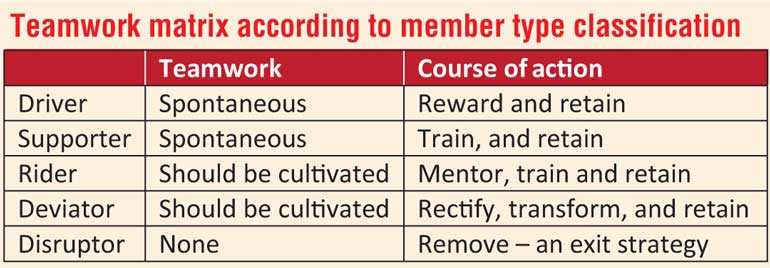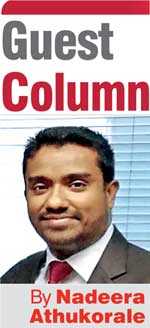Friday Mar 21, 2025
Friday Mar 21, 2025
Wednesday, 10 July 2019 00:00 - - {{hitsCtrl.values.hits}}

Every management course, textbook, and, management pandit all preach the importance of teamwork in the workplace. Though the pandits would always point out the importance and benefits it brings to the workplace it should be managed and administered. But why?
The concept of teamwork has come a long way. The fact that the word teamwork has become a household name, as a result the greater value of the teamwork seems to diminish. The very meaning and effectiveness of teamwork taken for granted.
How individuals react
Pandits and managers preach teamwork will do it. But how? Can the team members generate the teamwork by themselves? Few exceptional individuals would prove yes. But natural human feelings would be the selfishness. I do my work and that’s it.
Does fulfilment of individual responsibilities help a team achieve its goals and objectives? When the team fails, one of the culprits would be lack of teamwork. Individuals react and perform in a team according to their own judgment. But do we utilise correct techniques to harness teamwork.
Role of leadership
Article written by Theodore Henderson in Forbes.com in 2017 states that a leader is not intimidated in the least by the competence of his/her team. A confident leader would always equip his/her team to get the best performance. A leader should always empower and allow the space for the team members to innovate in their job role. In essence, a leader has a crucial role to play in the team. In other words the cogwheel of a team. Real world examples in sports would clarify this better.
Rivalry between the Australian Cricket team and the South African Cricket team was visible on and off the field due to the high performance both teams displayed during 1990s. Darryl Cullinan was a frequent victim of Shane Warne and the entire South African team fell victim to Shane Warne’s leg spin dominance. Stephen (Steve) Waugh who captained the Australian Cricket team in the 1999 World Cup was a resourceful leader.
It was Tom Moody, one of the team members of the World Cup winning Australian team, who conducted a workshop in 2011 and shared a story of what happened just before that memorable semi-final at Edgbaston, England.
During the day before the match, Steve Waugh asked the team members to compete with their equivalent player in the South African side. He had led from the front stating that he would be competing with Hansie Cronje since he was the Captain of South African team and he had asked Adam Gilchrist to compete with Mark Boucher (the wicket keepers), Glenn McGrath with Allan Donald, Tom Moody with Lance Klusener, and so on. Waugh’s idea had been if each team member on that day bettered his counter party, they would win the game. They went on to win that semi-final and the final against Pakistan to claim the world championship.
A look back at our own World Cup winning team in 1996 proves the role of leadership was crucial. Sri Lanka’s Captain Arjuna Ranatunga had been a strong captain who was not afraid to speak up and voice his opinion on what had to be done. His influence on the team was visible even off the field. He used to be the saviour when the team was in trouble.
When Sri Lanka’s ace spinner Muralitharan was called for chucking, the entire world saw how he reacted. That got the team united under the Captain. It was also evident he had the game plan to win the 1996 World Cup although no one gave Sri Lanka a chance. Ranatunga led from the front empowering the two openers to play freely in the first 15 overs when the field restrictions were in play (in the 1990s only two fielders were allowed outside the 30 yard circle) in the 15 overs.
The essence of these examples is that leaders play a pivotal role in directing a team and cultivation of team spirit to achieve a certain target.
In his article ‘World Class Teams’ in the 1992 Mckinsey Quarterly, former Captain of New Zealand’s All Blacks David Kirk points out six qualities of greatness of a team – namely, Vision, Ability, Divine Discontent, Discipline, Politics, and the Role of the Leader. He claims there is a vital function for the leader to perform. There are multiple capabilities in a team and the leader should identify those and utilise them in a particular combination so that the team will meet the immediate goal.
Teamwork in corporate context
In a corporate environment, there are many types of teams in action. It may be a project, or an operational function, or a management level committee – the role of leader is critical in order to receive the intended results.
We say not all five fingers are the same. Of course, they have visible differences. When it comes to people, it is not only the externally visible features but the personalities also count. This is mostly due to teams having multiple personalities in its members.
Team members may have different opinions when it comes to providing a solution to a client. Alternatively, some team members might play a neutral role in designing a solution rather following orders. These behaviours will lead to uncertainty but a leader has to persuade, direct, push, and control the team members to reach the intended goals. Therefore, it is always critically important for a leader to understand different member types in a team. In a corporate environment, we can always find five different team member types as set out below;
Driver: Drivers are creative, definitive, knows the direction, and target oriented performers. They are aware of their responsibilities and what is expected of them. Drivers are loyal to the team.
Supporter: Supporters are key contributors. They are willing to learn. With proper guidance and training, they can become ‘Drivers’ in the future. Supporters are loyal to the team.
Rider: Riders are team members who are neutral. They just make themselves present for the sake of doing a job. Riders are not mentally adjusted to make a significant contribution. They just follow what is assigned to them and do not understand the impact they can make towards the team. If they are not detected, could become deviators and ultimately disruptors.
Deviator: Deviators do not have focus. They sometimes deliver but most of the times they may delay the assigned tasks. Their performance is not consistent and they confuse the entire team.
Disruptor: Extremely disloyal to the team. They mislead the team with unethical behaviours such as gossiping, insulting ‘Drivers’, and circulating misinformation. Disruptors drag the team’s efforts. They will somehow try to slowdown and destroy team performance and path to the success.
1. Driver – Spontaneous: Drivers need to be retained in a team. Therefore, they have to be provided appropriate rewards. Rewards may come in different forms. It may be a promotion, a monetary reward, or a non-wage compensation.
2. Supporter – Spontaneous: These performers can be converted to ‘Drivers’. Therefore, they have to be provided work related and soft skills training in order to prepare themselves for the bigger role.
3. Rider – Should be cultivated: Riders need a bit of mentoring in order to get them on the track. Simultaneously they have to be provided work related training. These actions will ensure that they understand the common objectives of the team and how their contributions can make a better impact to the final result.
4. Deviator – Should be cultivated: Deviators need to be rectified through discipline and constant performance monitoring. But before that a one to one meeting with the member will be helpful in identifying the underlying issues that has put him/her in ‘Deviator’ category. It may be an internal or an external factor. For an example the team member is married with children and having problems at home or he/she may have an issue with a superior or a coworker. We have seen cordial one to one discussions do wonders when it comes to these problems. In the meantime the leader should ensure the transformation with positive feedback. Transformation would not arrive in one or two months. Patience will play a vital role.
5. Disruptor – None: Disruptors neither show nor exercise teamwork. They destroy the entire setup. It is always better to design an exit strategy for these individuals in a corporate environment such as by assigning them to another team with different responsibilities.
Once a leader identifies and categorises his team according to the above classification, it is easier to assess what course of action required in order to ensure teamwork. As per the above matrix for the number 1 and 2 team member types the teamwork is spontaneous but for number 3 and 4 it should be cultivated. However, for ‘Disruptors’ the course of action should be to remove them from the team since retaining this type of team members will not benefit either party.
In conclusion, the teamwork depends on the types of team members and the role of the leadership. If a team leader can identify the types and understand the team, he/she will be able to influence, equip, and, assign team members the tasks accordingly. This will create an environment to build an effective team which will ultimately generate teamwork. However, each individual including the leader do have a responsibility to contribute and take the team forward in order to reach the goals they are expected to achieve.
References
[The writer is a holder of B.Sc in Business Administration (Business Economics) Special degree and an MBA from Cardiff Metropolitan University in UK. He counts over 13 years’ working experience in different capacities in the corporate sector. The writer can be reached at [email protected].]
Discover Kapruka, the leading online shopping platform in Sri Lanka, where you can conveniently send Gifts and Flowers to your loved ones for any event including Valentine ’s Day. Explore a wide range of popular Shopping Categories on Kapruka, including Toys, Groceries, Electronics, Birthday Cakes, Fruits, Chocolates, Flower Bouquets, Clothing, Watches, Lingerie, Gift Sets and Jewellery. Also if you’re interested in selling with Kapruka, Partner Central by Kapruka is the best solution to start with. Moreover, through Kapruka Global Shop, you can also enjoy the convenience of purchasing products from renowned platforms like Amazon and eBay and have them delivered to Sri Lanka.
Discover Kapruka, the leading online shopping platform in Sri Lanka, where you can conveniently send Gifts and Flowers to your loved ones for any event including Valentine ’s Day. Explore a wide range of popular Shopping Categories on Kapruka, including Toys, Groceries, Electronics, Birthday Cakes, Fruits, Chocolates, Flower Bouquets, Clothing, Watches, Lingerie, Gift Sets and Jewellery. Also if you’re interested in selling with Kapruka, Partner Central by Kapruka is the best solution to start with. Moreover, through Kapruka Global Shop, you can also enjoy the convenience of purchasing products from renowned platforms like Amazon and eBay and have them delivered to Sri Lanka.